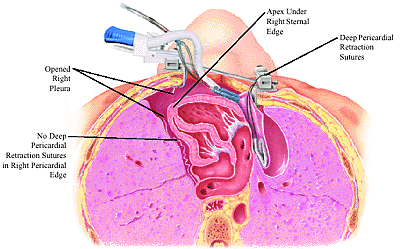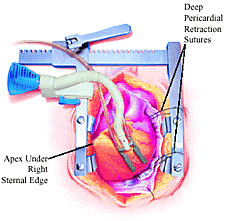|
Vertical Displacement for Exposure of Obtuse
Marginals and PDA by James C. Hart, M.D. The following displacement techniques, used in conjunction with deep pericardial retraction sutures, the Trendelenburg position, and table rotation, provide good vessel exposure while minimizing cardiac manipulation and maintaining hemodynamic stability (Figure 3 and Figure 4): 1. Extend the pericardial resection laterally at the level of the diaphragm. 2. Place warm pads in the posterior pericardial well. 3. Do not place a deep pericardial retraction suture in or suspend the right edge of the pericardium. 4. Open the right pleural space and elevate the right sternal edge to create space in the right chest for the rotated and displaced heart without compressing the right ventricle and right atrium. Excellent exposure of the lateral wall is obtained with minimal hemodynamic compromise. 5. Rotate and displace the heart until the apex
is under the right sternal edge. OMs and the PDA will be readily
accessible in this position. |
|
 Figure 4. Cross-section of vertical displacement for exposure of obtuse marginals and PDA |



